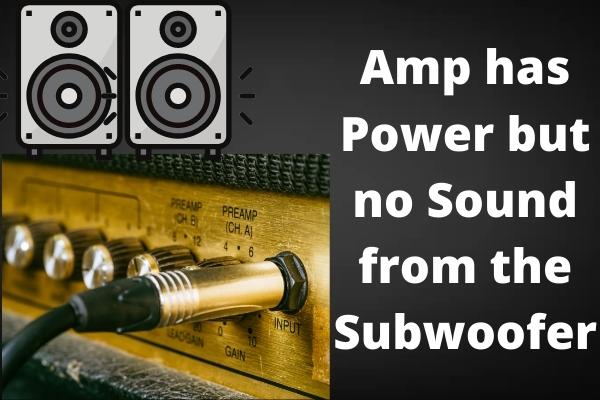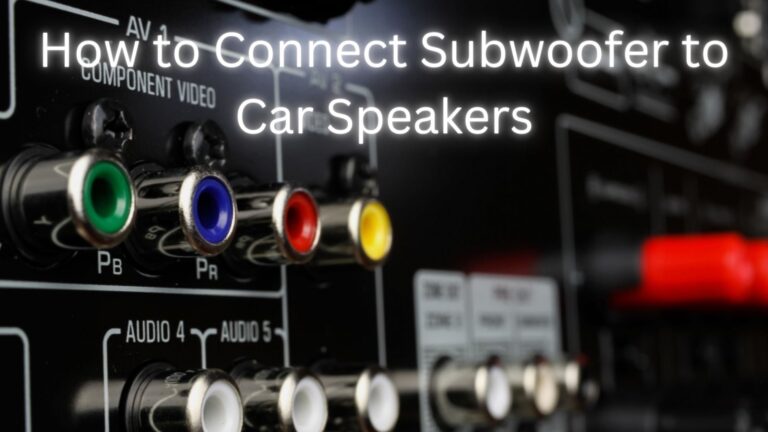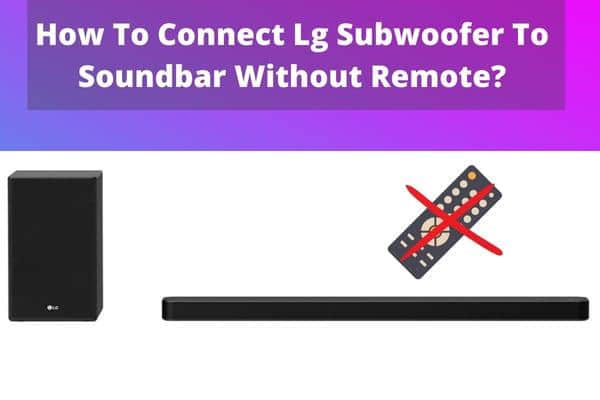
So if you have thought that the amp has power but no sound from the subwoofer then this article is for you. All of us know that an amplifier’s principal task is to offer the extra power your subwoofers need for creating bass and high sound quality.
If your amp has power but no sound from the subwoofer, this may be because the speaker or subwoofer will now no longer play bass, and you’ll no longer be able to revel in the sound coming from it.
If the amp is turned on but no sound is coming from the subs, there might be trouble with the amp or the subwoofer wiring. This complete article will show you the way to figure out what is wrong with your system and the way to fix it!
- Reasons the amp has power but the subwoofer is not working… problem solved!
- Check the wires
- Check amplifier settings
- Is Amplifier receiving a turn-on signal?
- Is the amplifier outputting a signal?
- The amplifier is set up on a non-conductive surface
- Is the amplifier receiving a music input signal?
- Final words
Reasons the amp has power but the subwoofer is not working… problem solved!
Even if the amplifier seems to have power, many automobile audio systems will have no sound from the subs, and there are plenty of reasons for this.
Some of this could be due to a defective amplifier (which you could effortlessly diagnose), but all of it may additionally be a result of different underlying troubles that will persist even if you replace your amp with a brand new one.
If your subwoofer abruptly stopped operating whilst the amplifier was turned on, or in case you consider you’ve got everything linked efficiently but your subs are not making any sound at all, the strategies below ought to assist you to determine what is wrong.
An automobile audio amplifier calls for some components to properly, and we will go over each of these in detail below.
Check the wires

Check the amp input connected to the head unit first. It ought to acquire an input signal from the head unit using speaker-level inputs (high-level inputs) or RCA-level inputs (low-level inputs).
Disconnect the RCA cords and connect your head unit to the amp with a brand-new pair to confirm this. Then, with the volume turned up, activate the head unit.
If it works with fresh RCA cables, the trouble was with the older set. If only one of them works, the problem is with the head unit instead of the amplifier.
The output of the audio system will be checked next. Connect the amp terminals to another testing speaker, one channel at a time.
If the amp is operating properly on all of these channels, your audio system is probably it might be because of defective speaker wiring or a faulty connection. The amp, on the other hand, is malfunctioning if the test audio system does not produce any sound.
Check amplifier settings

In the settings of most – if not all – aftermarket automobile stereos, there may be a separate subwoofer control. When the amp is turned on, your subs might not be capable of making any sound if it is turned off or set very low.
As a result, double-check your settings to make sure that the subwoofer output is enabled and that the dB levels are set higher than 0.
Is Amplifier receiving a turn-on signal?

The remote switch on the wire is a blue wire (generally with a white stripe) that controls the on and off of your amplifier.
Your amp will not switch on if it isn’t set up correctly, even though it has appropriate power and ground connections, or it’s going to continuously draw power and drain your battery overnight if it isn’t linked correctly.
When the ignition is turned on, the head unit sends a signal to the turn-on cord. This signal is dispatched to the amplifier turn-on circuit via the remote switch on the wire; when the amplifier detects this voltage, it activates the amplifier.
Two blue leads are included with a few head units. The first is in charge of turning on the amplifier and other processors (active crossovers, vehicle audio equalizers, and so on).
The power antenna is hooked up to the second lead. The latter will only work if the radio is turned on. When any other supply, which includes CD or Aux, is selected, it’ll lose power.
One factor to keep in mind: in older automobiles, connecting the remote turn on to the power antenna became a famous technique that worked wonderfully due to the fact the power antenna was up and running when the radio was turned on. However, the power antenna in most present-day automobiles we’ve seen may only acquire power while the head unit is in AM/FM mode.
The power antenna wire will stop receiving power and your amplifier will now no longer switch on if you turn to Auxiliary input, CD player, satellite radio, SD card, etc.
If your amplifier only works with the radio, you would possibly want to attach the power antenna line to the amplifier instead of the remote lead.
Using that said, check this connection via means of switching your head unit to a supply aside from the radio and checking the voltage among the remote switch on the terminal in your amp and the ground with a voltmeter. It ought to be between 12 and 14 volts.
If it isn’t, switch the head unit to the radio and test for power. If it does, you are most probably only using the power antenna lead and not the remote turn-on lead. If there’s no voltage, irrespective of whether or not the radio or any other source is used, there may probably be a problem.
Is the amplifier outputting a signal?
It’s time to confirm the speaker outputs now that we understand the amplifier is receiving the signal and turning it. To test if your amplifier is generating a signal, disconnect it from your vehicle’s audio system and connect an excellent test speaker to one of the amplifier’s channels at a time.
If the amplifier can drive it on all channels, then something is amiss downstream (after the amplifier). This might be because of a malfunctioning audio system, speaker wiring issues, or an awful connection. If the amplifier activates but no output is dispatched to the checked speaker, you most probably have a damaged amplifier, however, you ought to double-check.
The amplifier is set up on a non-conductive surface
Ensure that the amplifier is set up on a non-conductive surface.
After that, make sure that no part of the amplifier comes into touch with any metallic withinside the vehicle. This can bring about numerous issues, which include signal clipping and the amp getting into protected mode.
Is the amplifier receiving a music input signal?
Your purpose is to get music out. Speaker level inputs (also referred to as high-level inputs – not all amps have these) or low-level inputs are used to offer music to the amplifier (also referred to as RCA inputs or low-level inputs) RCA outputs are observed on nearly every modern aftermarket lookalike head unit these days. Some have up to three output pairs (front, rear, subwoofer).
Factory receivers, on the other hand, will only have speaker outputs that may be related to high-level inputs or transformed to low-level (RCA) outputs with the assistance of a line output converter.
If your subwoofer is not operating, however the amp is powered, test to look if the amp is getting input from your head unit. This is an easy method in that you simply disconnect the RCA cables from every device and replace them with a great set.
Check to look if the head unit is turned on and the volume is turned up. If the whole thing works after bypassing the prevailing RCA wires, all you need to do now could be to replace them with an appropriate set.
If you can listen from one input but not from another, the problem is with your head unit, not your amplifier. If these connections (low or high) are properly linked, and the wires are in appropriate condition but your amplifier still does not produce any output, you will need to test the gain on your amplifier.
The latter is liable for matching the head unit’s output signal to the amplifier’s input section. So, with the head unit turned on and the volume set to more or less halfway, increase the gain control on your amplifier to test if any sound comes out. If you are listening to music via an audio system or subwoofers, keep adjusting the gain on your amp till it sounds clear.
If you still do not listen to anything, use a portable music player (CD or MP3) with a 3.5mm to RCA adaptor twine and plug it into the amplifier’s input to see if it is because of a lack of signal. When your subs start to make noise, you understand it is a double with the input signal.
This can represent one of two things: either the connection is bad, or any other device upstream, including a crossover, is blocking the signal from reaching the amplifier.
Final words
That’s all there’s to mending an automobile amplifier that looks to inappropriate running order but isn’t always producing any sound from the subs.
Most of the time, it is a fundamental and quick fix that you can do yourself at home if you have some spare time instead of going to your local car audio store to save money.
Leave a comment below if you can’t figure out what’s wrong with your car audio system or if you want to pick my brain about anything in the article. We’d be delighted to see how we can assist.






